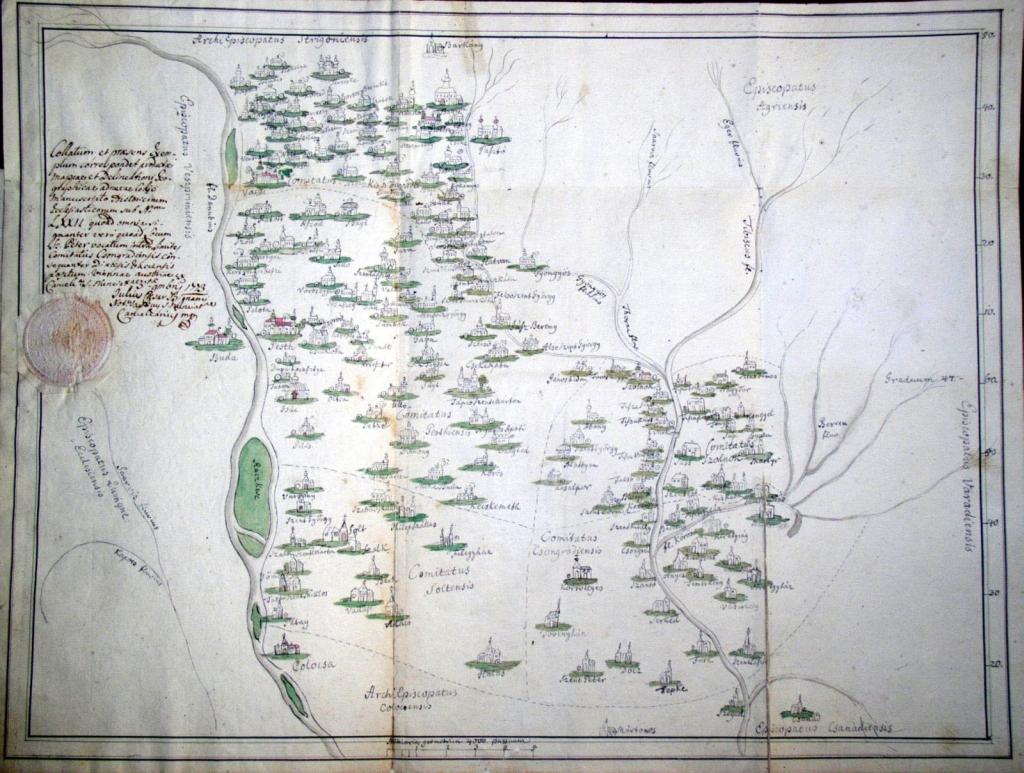by Katalin Pataki
Illustration: Map of the Diocese of Vác, 1773 (copy of the original document published in 1675). With the kind permission of the Archives of the Diocese and Chapter in Vác (Váci Püspöki és Káptalani Levéltár)
The bishops of the Habsburg realms were obliged to swear an oath of allegiance to the ruler from 1782. The introduction of the oath by Joseph II (1780–1790) coincided with the redefinition of the legal and geographical boundaries of papal, episcopal, and state power. The ecclesiastical reforms of Maria Theresa and Joseph II wouldn’t have been possible without the bishops’ compliance with their agenda. However, the bishops’ loyalty found expression not only in the act of taking an oath but also in steps taken in accordance with the detailed instructions sent to them by the central authorities. A vast array of policies required the bishops to conduct surveys in their dioceses, and the new regulations defined the spatial scope of the bishops’ activity in far more detail than ever before. The topography of the dioceses became strongly intertwined with the processes of governmental decision making. The bishops had to inform the state authorities of the number of Catholic inhabitants in their dioceses and the conditions of the parishes serving them. They were also expected to reveal gaps in the parish system, such as problematic geographical distances from the nearest church and shortages of ecclesiastical personnel, and to find ways of improving the parishioners’ access to pastoral care.
The dissolution of roughly one third of the monasteries provided the economic basis for the foundation of new parishes, and the remaining religious houses were increasingly expected to support and complement the activity of the parish priests. The redistribution of the resources of the monasteries was also coordinated by the bishops, and they had to make their decisions “map-mindedly”, i.e. paying close attention to the topographical considerations of the task of providing pastoral care.
Although a great deal has been written on the connection between church reforms and the use of maps and topographical descriptions from the mid-eighteenth century, we still do not have comprehensive and accurate maps of ecclesiastical institutions – particularly of parishes and monasteries – from before the early nineteenth century. The question of the geographical boundaries of the parishes and dioceses also merits more thorough investigation.
The gaps in our knowledge could be significantly reduced by using the existing digital databases more efficiently. Historians of East Central Europe in particular could benefit a lot from a greater familiarity with one another’s digital projects, and they could use the various findings of these projects to explore international and inter-confessional contacts in the region. If we were to interlink the available data and refine and increase the technical interoperability of databases, this would enable us better to overcome linguistic and chronological boundaries.
The workshop “The Transition from Medieval to Modern: the Transformation of Parishes in East Central Europe, c. 1500 – c. 1800” was a significant step in this direction. The meeting took place at the Károli Gáspár University of the Reformed Church in Hungary, Budapest, on 23 May 2024. The organizers invited experts on ecclesiastical history from Poland, the Czech Republic, Croatia, and Hungary, who presented their research with a special focus on how they had benefited from working with digital datasets and had explored possibilities for further collaborative undertakings on “the transition from the late medieval parish system (c. 1500) to the multi-confessional church structures (c. 1800) in East-Central Europe”.
The presentations were given by Bogumił Szady (KUL, Poland), Paweł Kras (Centre for Medieval Studies – KUL, Poland), Beatrix F. Romhányi (KRE, Hungary), David Trojan (Centre for Medieval Studies Prague, Czech Republic), Gábor Demeter (HUN-REN Historical Institute, Hungary), Dino Mujadžević (Croatian Institute of History, Croatia) and Katalin Pataki (HUN-REN Historical Institute, Hungary).
The ongoing research of the participants in the workshop was inspiring from the perspective of the Negotiating Sovereignty project as well. Further investigation of the parishes of Central Europe and a data-driven approach will further a more nuanced understanding of how the abstract and general concept of loyalty expressed in the oath of allegiance gained a more concrete and material (one could even say, a more secular) dimension when the bishops became chief executors of Joseph II’s ecclesiastical policies and transformed the parish system of their dioceses in accordance with the agenda of the evolving modern state.
